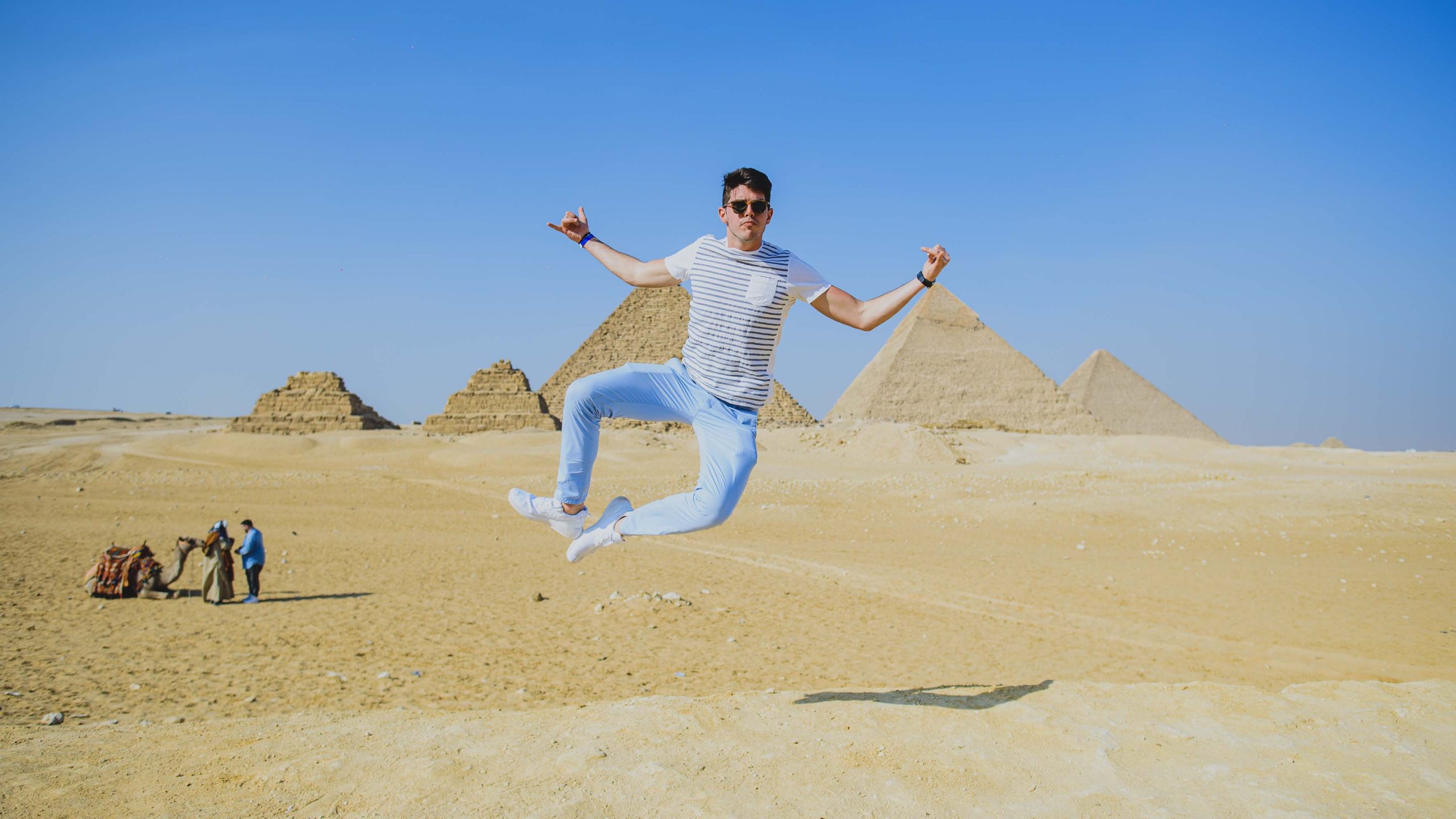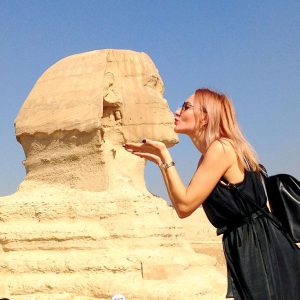
Adventure Time
The Great Pyramids of Giza
When most people think about towns and cities in Egypt they only tend to think of the major cities or the ones associated with tourist attractions, but there are actually more than 200 towns and cities which have populations of over 15 milion. Among the major tourist sites, there is only one considered to be “The major” and on top of any list – The Pyramids of Giza. There are three main Pyramids here, which were built in the 4th Dynasty (circa 4650 B.C). The Pyramids of Ancient Egypt were built as tombs for Kings (and Queens), and it was the exclusive privilege to have a Pyramid tomb. However, this tradition only applied in the Old and Middle Kingdoms. Today there are more than 115 Pyramids in Egypt; the most famous ones are those at Giza. The Pyramids of Ancient Egypt were built as tombs for Kings (and Queens), and it was the exclusive privilege to have a Pyramid tomb
Now let’s go for a little tour around the site of the Pyramids and try to explore the magnificence of the area:
The Great Pyramid of Khufu
The Great Pyramid of Khufu is by far the most famous Pyramid in Egypt, the biggest, tallest, and most intact. After its construction it became one of the “Seven Wonders Of The World”, and today, it is the only one of them remaining. For a period of 4300 years, the Pyramid was also the tallest building on earth, until the French built the Eiffel Tower in 1889 to take that accolade. Khufu’s Pyramid is built entirely of limestone, and is considered an architectural masterpiece. It contains around 2,300,000 blocks ranging in weight from 2.5 tons to 20tons, in total 6 million tons and is built on a square base with sides measuring about 230m (755ft), covering 13 acres! Its four sides face the four cardinal points precisely and it has an angle of 52 degrees. The original height of the Pyramid was 146.5m (488ft), but today it is only 139m (463ft) high, the 8m (27ft) that is missing is due to the theft of the fine quality limestone covering, or casing stones, by the Ottoman Turks in the 15 Century A.D, to build houses and Mosques in Cairo. Nothing was found inside, as it was plundered in antiquity.
Please Note: If you attempt to go inside the Pyramid, you will have to bend down all the way till you reach the burial chamber!
The Pyramid of Khafre
Khafre’s Pyramid, or the 2nd Pyramid, is easily recognizable by the layers of its original casing stones that still remain near its summit and this, along with the fact that it actually stands on a higher part of the plateau, gives the impression that it is taller than the Great Pyramid. An optical illusion, as it is only 136m (446 ft) tall, with sides of 214.5m (704ft), a surface area of 11 acres and an angle of 53 degrees. It also has lost some of its original height through the years, once being 143.5m (471ft) tall.
The only similarity to his father’s Pyramid is the entrance in the same, north facing side. There are no corridors leading into the heart of this Pyramid, the burial chamber being underground, and a long descending passageway has to be negotiated to reach it. This entrance is 50 feet (15m) above ground level, leading to the narrow passage, which descends at a 25-degree angle into the large burial chamber, which measures 14.2m by 5m by 6.9m (46.5ft by 16.5ft by 22.5ft). To take the weight of the pyramid, the roof of the chamber is set at the same angles as the pyramid face. A large, black sarcophagus is found in this room.
A lower corridor is directly under the upper corridor, and once contained a portcullis that could be lowered to prevent entry as well as an unfinished burial chamber, which was cut from the bedrock and, it is thought, unused. Like the upper corridor, this one has a 25-degree slope, it then levels out, climbs slightly, and eventually the 2 of them join together. The united passageway then leads to the burial chamber.
The Pyramid of Menkaure
Khafre’s son, Menkaure, built the smallest of the 3 main Pyramids on the Giza Plateau. This one was only a mere 65.5m (215ft) tall, nowadays 62m (203ft), with sides of only 105m (344ft) and an angle of 51.3 degrees. It is thought that this Pyramid was altered during its construction, and made a lot bigger than originally planned. The original, smaller Pyramid had a simple descending corridor and burial chamber, but when it was enlarged, a new corridor was built with 3 portcullises and a small panelled chamber. Later still, another burial chamber, along with a storeroom were added at a lower level. This Pyramid, like its 2 neighbors, has a north facing entrance.
Apart from the size, Menkaure’s Pyramid differed from the other 2 in the choice of casing stones. Whereas the Pyramids of his father and grandfather were completely cased in fine, white, Turah limestone, Menkaure’s Pyramid was only partly cased in Turah limestone, from about 15m up! The first 15 meters was cased with pink granite, which had come from Aswan, the last of which was taken by Muhammad Ali Pasha (1805-1848) who used them to construct his arsenal in Alexandria.
The Great Sphinx
The Great Sphinx, or as the ancients knew it, “Shesib Ankh” or “the living image”, has to be one of the most recognizable constructions in history. Think of the Sphinx and you automatically think of Egypt and the Giza Plateau. Sculpted from soft sandstone, many believe that it would have disappeared long ago had it not been buried in the sand for so many long periods in its lifetime. The body is 60m (200ft) long and 20m (65ft) tall. Its face is 4m (13ft) wide with eyes measuring 2m (6 ft) high. It faces the rising sun, and was revered so much by the ancients, that they built a temple in front of it.
The 18th Dynasty King, Thutmose IV installed a stele between its front paws, describing how, when Thutmose was a young Prince, he had gone hunting and fell asleep in the shade of the Sphinx ‘s head. Thutmose had a dream where Ra Hor-Akhty the sun God, talking through the Sphinx, spoke to him, telling the young Prince to clear away the sand because the Sphinx was choking on it. The Sphinx said to him that if he did this, he would become King of Egypt. Thutmose cleared away all the sand and s after 2 years, the god fulfilled his promise to the price and he was made king of Egypt
Today, part of the “uraeus” (the sacred cobra at the forehead ), and the nose are missing (not shot off by Napoleon’s men as many believe, but were destroyed by Muhammad Sa’im Al-Dahr, a Sufi fanatic from the Khanqah of Sa’id Al-Su’ada. In 1378, upon finding the Egyptian peasants making offerings to the Sphinx in the hope of increasing their harvest, Sa’im Al-Dahr was so outraged that he destroyed the nose!).
I hope this gave you a glimpse of information about the Pyramids of Giza.




